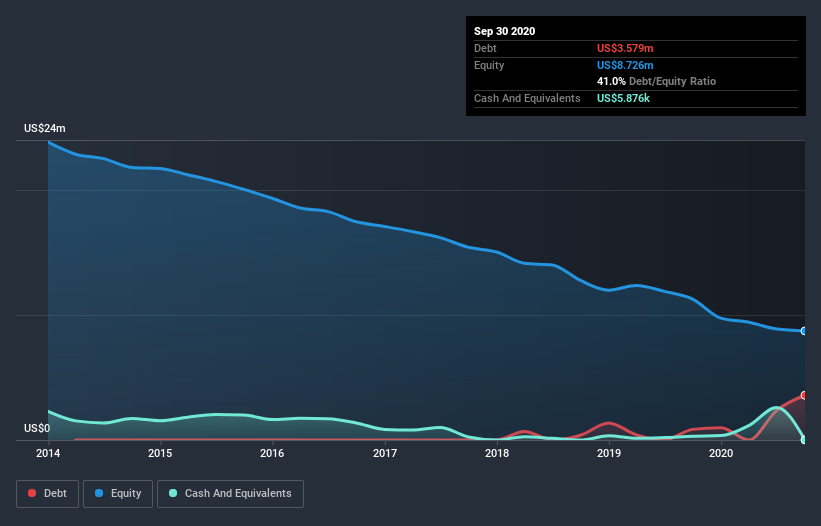- United States
- /
- Medical Equipment
- /
- OTCPK:AHPI.Q
Here's Why Allied Healthcare Products (NASDAQ:AHPI) Can Afford Some Debt
Some say volatility, rather than debt, is the best way to think about risk as an investor, but Warren Buffett famously said that 'Volatility is far from synonymous with risk.' It's only natural to consider a company's balance sheet when you examine how risky it is, since debt is often involved when a business collapses. Importantly, Allied Healthcare Products, Inc. (NASDAQ:AHPI) does carry debt. But is this debt a concern to shareholders?
When Is Debt Dangerous?
Debt assists a business until the business has trouble paying it off, either with new capital or with free cash flow. Ultimately, if the company can't fulfill its legal obligations to repay debt, shareholders could walk away with nothing. However, a more usual (but still expensive) situation is where a company must dilute shareholders at a cheap share price simply to get debt under control. Of course, plenty of companies use debt to fund growth, without any negative consequences. The first thing to do when considering how much debt a business uses is to look at its cash and debt together.
Check out our latest analysis for Allied Healthcare Products
What Is Allied Healthcare Products's Debt?
You can click the graphic below for the historical numbers, but it shows that as of September 2020 Allied Healthcare Products had US$3.58m of debt, an increase on US$850.0k, over one year. And it doesn't have much cash, so its net debt is about the same.

How Healthy Is Allied Healthcare Products's Balance Sheet?
According to the last reported balance sheet, Allied Healthcare Products had liabilities of US$9.86m due within 12 months, and liabilities of US$1.10m due beyond 12 months. Offsetting these obligations, it had cash of US$5.9k as well as receivables valued at US$3.29m due within 12 months. So it has liabilities totalling US$7.67m more than its cash and near-term receivables, combined.
This deficit isn't so bad because Allied Healthcare Products is worth US$19.4m, and thus could probably raise enough capital to shore up its balance sheet, if the need arose. But it's clear that we should definitely closely examine whether it can manage its debt without dilution. When analysing debt levels, the balance sheet is the obvious place to start. But you can't view debt in total isolation; since Allied Healthcare Products will need earnings to service that debt. So if you're keen to discover more about its earnings, it might be worth checking out this graph of its long term earnings trend.
In the last year Allied Healthcare Products wasn't profitable at an EBIT level, but managed to grow its revenue by 6.3%, to US$34m. That rate of growth is a bit slow for our taste, but it takes all types to make a world.
Caveat Emptor
Importantly, Allied Healthcare Products had an earnings before interest and tax (EBIT) loss over the last year. Indeed, it lost a very considerable US$2.6m at the EBIT level. Considering that alongside the liabilities mentioned above does not give us much confidence that company should be using so much debt. Quite frankly we think the balance sheet is far from match-fit, although it could be improved with time. However, it doesn't help that it burned through US$3.0m of cash over the last year. So suffice it to say we consider the stock very risky. The balance sheet is clearly the area to focus on when you are analysing debt. However, not all investment risk resides within the balance sheet - far from it. Be aware that Allied Healthcare Products is showing 4 warning signs in our investment analysis , and 2 of those are potentially serious...
Of course, if you're the type of investor who prefers buying stocks without the burden of debt, then don't hesitate to discover our exclusive list of net cash growth stocks, today.
If you decide to trade Allied Healthcare Products, use the lowest-cost* platform that is rated #1 Overall by Barron’s, Interactive Brokers. Trade stocks, options, futures, forex, bonds and funds on 135 markets, all from a single integrated account. Promoted
New: Manage All Your Stock Portfolios in One Place
We've created the ultimate portfolio companion for stock investors, and it's free.
• Connect an unlimited number of Portfolios and see your total in one currency
• Be alerted to new Warning Signs or Risks via email or mobile
• Track the Fair Value of your stocks
This article by Simply Wall St is general in nature. It does not constitute a recommendation to buy or sell any stock, and does not take account of your objectives, or your financial situation. We aim to bring you long-term focused analysis driven by fundamental data. Note that our analysis may not factor in the latest price-sensitive company announcements or qualitative material. Simply Wall St has no position in any stocks mentioned.
*Interactive Brokers Rated Lowest Cost Broker by StockBrokers.com Annual Online Review 2020
Have feedback on this article? Concerned about the content? Get in touch with us directly. Alternatively, email editorial-team@simplywallst.com.
About OTCPK:AHPI.Q
Allied Healthcare Products
Allied Healthcare Products, Inc. manufactures and markets respiratory products for use in the health care industry in a range of hospitals and alternate site settings worldwide.
Weak fundamentals or lack of information.
Market Insights
Community Narratives



